The EV sector industrial subsidy figures released last week by @CSIS are inflated by at least ~$80B, mainly from poor assumptions made to calculate the NEV Sales Tax Exemption that (i) don't pass the sanity check and (ii) are out-of-whack with disclosed actuals amounts.
🧵
🧵

As disclosed in the CSIS analysis, the Sales Tax Exemption assumption is based on a very simple premise:
To incent purchases of NEVs (new energy vehicles i.e. BEVs+PHEVs) over ICE vehicles, most NEVs are exempt from the sales tax exemption, which is assumed to be 10%.
To incent purchases of NEVs (new energy vehicles i.e. BEVs+PHEVs) over ICE vehicles, most NEVs are exempt from the sales tax exemption, which is assumed to be 10%.

$39.5B of Sales Tax Exemption in '23 thus implies that there were at least $395B worth of NEVs sold in China based on CSIS assumptions.
Since we know how many NEVs were sold (~7.9M passenger and ~0.3M commercial), we can back out the implied average selling price (ASP).
Since we know how many NEVs were sold (~7.9M passenger and ~0.3M commercial), we can back out the implied average selling price (ASP).

CSIS discloses ASP assumption of ¥1.2M for large commercial vehicles. This would imply ~$54B in commercial vehicle NEV sales in '23, leaving $341B for light passenger vehicles.
Based on ~7.9M passenger NEVs sold in '23, this implies an ASP of $43k (¥310k).
Based on ~7.9M passenger NEVs sold in '23, this implies an ASP of $43k (¥310k).

This does not pass the sanity check, nor is it consistent with CSIS' own assumptions (passenger NEV ASP is ¥250k).
e.g. the best-selling models in China are compact and mid-size NEVs with ASPs in the ¥120-250k range.
e.g. the best-selling models in China are compact and mid-size NEVs with ASPs in the ¥120-250k range.
In any case, we can also cross-check this assumption with actual disclosed figures.
The Ministry of Finance disclosed last year cumulative NEV Sales Tax Exemptions through 2022 of ~¥200 billion (~$29B) + another ~¥115 billion (~$16B) in 2023.
This suggests the CSIS estimate for Salex Tax Exemptions is overstated by 2.5-2.6x
The Ministry of Finance disclosed last year cumulative NEV Sales Tax Exemptions through 2022 of ~¥200 billion (~$29B) + another ~¥115 billion (~$16B) in 2023.
This suggests the CSIS estimate for Salex Tax Exemptions is overstated by 2.5-2.6x

Factoring in more accurate assumptions that are more in line with these actuals, I have done my own analysis on Chinese EV sector assumptions and arrived at ~$147B, ~$83B lower than the CSIS estimate. 

Based on this, more interesting is what happens going forward IMO.
Per below, the NEV Sales Tax Exemption has been extended for 4 more years, but like the Buyer's Rebate before gradually eases out.
For example, the maximum exemption halves in 2026 to ¥15k per NEV.


Per below, the NEV Sales Tax Exemption has been extended for 4 more years, but like the Buyer's Rebate before gradually eases out.
For example, the maximum exemption halves in 2026 to ¥15k per NEV.


I've taken the EV sector subsidies analysis out through 2030 assuming the Sales Tax Exemption is retired after this current program ends.
As you can see avg. subsidies per vehicle continue to fall gradually, from $2,700 in '23 to <$200 by '30.
As you can see avg. subsidies per vehicle continue to fall gradually, from $2,700 in '23 to <$200 by '30.

If we take the model even further out to 2040, China will have spent ~$330B in total subsidies on the EV sector.
Paired against ~704M cumulative NEV sales through 2040, this would average out cumulatively to a subsidy of ~$468 per vehicle.
Paired against ~704M cumulative NEV sales through 2040, this would average out cumulatively to a subsidy of ~$468 per vehicle.
I think the lesson here is pretty clear and does not need overstated subsidy estimates to make the point.
The key to any successful industrial policy subsidy program is providing support to a domestic industry to achieve scale and profitability so subsidies can be gradually withdrawn over time.
The last point is key. If industrial policy and subsidies cannot achieve industry scale and self-sustaining profitability, you end up with a non-competitive sector that continues to suck up fiscal resources indefinitely.
The key to any successful industrial policy subsidy program is providing support to a domestic industry to achieve scale and profitability so subsidies can be gradually withdrawn over time.
The last point is key. If industrial policy and subsidies cannot achieve industry scale and self-sustaining profitability, you end up with a non-competitive sector that continues to suck up fiscal resources indefinitely.
The development of the Chinese EV sector has followed this principle.
Subsidies per car have fallen from >$20k per vehicle to ~$2k per vehicle over the last decade and will be effectively completed by 2027.
Subsidies per car have fallen from >$20k per vehicle to ~$2k per vehicle over the last decade and will be effectively completed by 2027.

The question for Western policymakers is not about the need to develop and retain an EV industry using industrial policy and subsidies, like China has done. That should be pretty clear, the answer is yes.
It is about execution of said industrial policy. Specifically, are we seeing aggregate subsidies per NEV go down over time at a satisfactory pace?
It is about execution of said industrial policy. Specifically, are we seeing aggregate subsidies per NEV go down over time at a satisfactory pace?
Remember there are other new industries beyond EVs.
That China is a few years away from withdrawing subsidies from EVs just means that those fiscal resources will soon be available to support development of other future industries.
If one is stuck subsidizing old industries indefinitely this just means less fiscal resources available to spur development of new ones.
That China is a few years away from withdrawing subsidies from EVs just means that those fiscal resources will soon be available to support development of other future industries.
If one is stuck subsidizing old industries indefinitely this just means less fiscal resources available to spur development of new ones.
This is not the first time I’ve seen highly questionable assumptions in CSIS analysis on China.
Its analysis of COMAC development costs was even more egregious and off by 6-14x.
These numbers influence policy and decision-making. Isn’t it important that we get them right?
Its analysis of COMAC development costs was even more egregious and off by 6-14x.
These numbers influence policy and decision-making. Isn’t it important that we get them right?
https://twitter.com/glennluk/status/1767770559599743063
Bad analysis does enormous disservice to our policymaking.
13 years ago, Chinese NEV industry subsidies were scoffed at as “wasted investment”.
Instead of breeding complacency, maybe we should have taken them seriously. Catching up will be that much harder as a result.
13 years ago, Chinese NEV industry subsidies were scoffed at as “wasted investment”.
Instead of breeding complacency, maybe we should have taken them seriously. Catching up will be that much harder as a result.
https://twitter.com/glennluk/status/1800213403803566552
Another interesting datapoint from this analysis:
~2/3rds of NEV sector subsidies were focused aimed at stimulating the consumer demand side with <1/3rd focused on production.
Nascent industries require coordinated stimulation of both supply and demand.
This also contradicts prevailing narratives about how China "focuses disproportionately on the supply-side at the expense of households/consumers".
~2/3rds of NEV sector subsidies were focused aimed at stimulating the consumer demand side with <1/3rd focused on production.
Nascent industries require coordinated stimulation of both supply and demand.
This also contradicts prevailing narratives about how China "focuses disproportionately on the supply-side at the expense of households/consumers".

• • •
Missing some Tweet in this thread? You can try to
force a refresh











